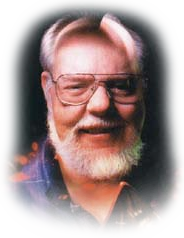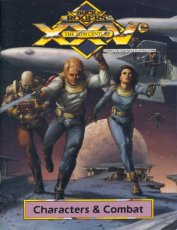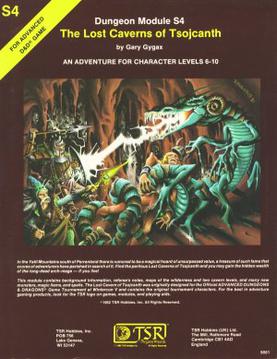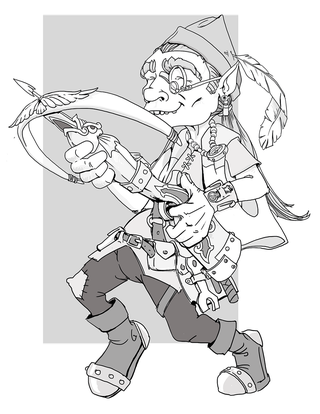Related Research Articles

Dungeons & Dragons is a fantasy tabletop role-playing game (RPG) originally created and designed by Gary Gygax and Dave Arneson. The game was first published in 1974 by Tactical Studies Rules, Inc. (TSR). It has been published by Wizards of the Coast, later a subsidiary of Hasbro, since 1997. The game was derived from miniature wargames, with a variation of the 1971 game Chainmail serving as the initial rule system. D&D's publication is commonly recognized as the beginning of modern role-playing games and the role-playing game industry, and also deeply influenced video games, especially the role-playing video game genre.

Ernest Gary Gygax was an American game designer and author best known for co-creating the pioneering tabletop role-playing game Dungeons & Dragons (D&D) with Dave Arneson.
Greyhawk, also known as the World of Greyhawk, is a fictional world designed as a campaign setting for the Dungeons & Dragons fantasy roleplaying game. Although not the first campaign world developed for Dungeons & Dragons—Dave Arneson's Blackmoor campaign predated it by about a year—the world of Greyhawk closely identified with early development of the game beginning in 1972, and after being published it remained associated with Dungeons & Dragons publications until 2008. The world itself started as a simple dungeon under a castle designed by Gary Gygax for the amusement of his children and friends, but it was rapidly expanded to include not only a complex multi-layered dungeon environment, but also the nearby city of Greyhawk, and eventually an entire world. In addition to the campaign world, which was published in several editions over twenty years, Greyhawk was also used as the setting for many adventures published in support of the game, as well as for RPGA's massively shared Living Greyhawk campaign from 2000–2008.

TSR, Inc. was an American game publishing company, best known as the original publisher of Dungeons & Dragons (D&D). Its earliest incarnation, Tactical Studies Rules, was founded in October 1973 by Gary Gygax and Don Kaye. Gygax had been unable to find a publisher for D&D, a new type of game he and Dave Arneson were co-developing, so he founded the new company with Kaye to self-publish their products. Needing financing to bring their new game to market, Gygax and Kaye brought in Brian Blume in December as an equal partner. Dungeons & Dragons is generally considered the first tabletop role-playing game (TTRPG), and established the genre. When Kaye died suddenly in 1975, the Tactical Studies Rules partnership restructured into TSR Hobbies, Inc. and accepted investment from Blume's father Melvin. With the popular D&D as its main product, TSR Hobbies became a major force in the games industry by the late 1970s. Melvin Blume eventually transferred his shares to his other son Kevin, making the two Blume brothers the largest shareholders in TSR Hobbies.

David Lance Arneson was an American game designer best known for co-developing the first published role-playing game (RPG), Dungeons & Dragons, with Gary Gygax, in the early 1970s. Arneson's early work was fundamental to the role-playing game (RPG) genre, pioneering devices now considered to be archetypical, such as cooperative play to develop a storyline instead of individual competitive play to "win" and adventuring in dungeon, town, and wilderness settings as presented by a neutral judge who doubles as the voice and consciousness of all characters aside from the player characters.

Tomb of Horrors is an adventure module written by Gary Gygax for the Dungeons & Dragons (D&D) role-playing game. It was originally written for and used at the 1975 Origins 1 convention. Gygax designed the adventure both to challenge the skill of expert players in his own campaign and to test players who boasted of having mighty player characters able to best any challenge. The module, coded S1, was the first in the S-series, or special series of modules. Several versions of the adventure have been published, the first in 1978, and the most recent, for the fifth edition of D&D, in 2017 as one of the included adventures in Tales from the Yawning Portal. The module also served as the basis for a novel published in 2002.

Dungeonland (EX1) is a 1983 adventure module for the Dungeons & Dragons (D&D) roleplaying game, written by Gary Gygax for use with the First Edition Advanced Dungeons & Dragons (AD&D) rules. It is an adaptation of Lewis Carroll's 1865 novel Alice's Adventures in Wonderland, with the various characters from the book translated into AD&D terms.
Several different editions of the Dungeons & Dragons (D&D) fantasy role-playing game have been produced since 1974. The current publisher of D&D, Wizards of the Coast, produces new materials only for the most current edition of the game. However, many D&D fans continue to play older versions of the game and some third-party companies continue to publish materials compatible with these older editions.

Buck Rogers XXVC is a game setting created by TSR, Inc. in the late 1980s. Products based on this setting include novels, graphic novels, a role-playing game (RPG), board game, and video games. The setting was active from 1988 until 1995.

Mordenkainen is a fictional wizard from the World of Greyhawk campaign setting for the Dungeons & Dragons roleplaying game. He was created by Gary Gygax as a player character, only months after the start of Gygax's Greyhawk campaign and is therefore one of the oldest characters continuously associated with Dungeons & Dragons.
The monk is a playable character class in most editions of the Dungeons & Dragons fantasy role-playing game. A D&D monk is a fantasy martial artist, specializing in unarmed combat.

Iggwilv is a fictional wizard from the Greyhawk campaign setting for the Dungeons & Dragons roleplaying game. She was created by Gary Gygax.

Jacob Franklin Mentzer III is an American fantasy author and game designer who worked on early materials for the Dungeons & Dragons (D&D) fantasy role-playing game. He was an employee of TSR, Inc. from 1980 to 1986, spending part of that time as creative advisor to the chairman of the board, Gary Gygax. He also founded the Role-Playing Games Association (RPGA) during his time with TSR.

The Lost Caverns of Tsojcanth is an adventure module for the Dungeons & Dragons fantasy role-playing game. It was written by Gary Gygax and published by TSR in 1982 for the first edition Advanced Dungeons & Dragons (AD&D) rules. The 64-page adventure bears the code "S4" and is set in the Greyhawk campaign setting. It is divided into two parts, a 32-page adventure, and a 32-page booklet of monsters and magic items. The plot involves the player characters investigating rumors of lost treasure. After traversing a wilderness and two levels of dungeons, the players face Drelnza, the vampiric daughter of long-deceased archmage Iggwilv.
The role-playing game Dungeons & Dragons (D&D), which receives significant attention in the media and in popular culture, has been the subject of numerous controversies. The game sometimes received unfavorable coverage, especially during its early years in the early 1980s. Because the term D&D may be mistakenly used to refer to all types of role-playing games, some controversies regarding D&D mistakenly pertain to role-playing games in general, or to the literary genre of fantasy. Some controversies concern the game and its alleged impact on those who play it, while others concern business issues at the game's original publisher, TSR. The game is now owned by Wizards of the Coast.
Donald R. Kaye was the co-founder of Tactical Studies Rules (TSR), the game publishing company best known for their Dungeons & Dragons (D&D) role-playing game. He and TSR co-founder Gary Gygax had been friends since childhood, sharing an interest in miniature war games. In 1972, Kaye created Murlynd, one of the first D&D characters, and play-tested him in Gygax's Castle Greyhawk campaign. Kaye and Gygax were convinced that D&D and similar games were an excellent business opportunity, and together they founded Tactical Studies Rules in 1973. However, only two years later, just as sales of D&D started to rise, Kaye unexpectedly died of a heart attack at age 36.
Brian John Blume was an American game designer and writer, principally known as a former business partner of Gary Gygax at TSR, Inc., original publishers of the fantasy role-playing game Dungeons & Dragons.
Flint Dille is an American screenwriter, game designer and novelist. He is best known for his animated work on Transformers, G.I. Joe, An American Tail: Fievel Goes West, and his game-writing, The Chronicles of Riddick: Escape from Butcher Bay, and Dead to Rights, as well as a non-fiction book written with John Zuur Platten, The Ultimate Guide to Video Game Writing and Design .

In the Dungeons & Dragons fantasy role-playing game, gnomes are one of the core races available for play as player characters. Some speculate that they are closely related to dwarves; however, gnomes are smaller and more tolerant of other races, nature, and magic. Depending on the setting and subrace, they are often skilled with illusion magic or engineering. Gnomes are small humanoids, standing 3–3.5 feet (91–107 cm) tall.
References
- 1 2 "Original Space Adventurer Buck Rogers Stars in 21st Century Auction". Art Daily. Retrieved 2010-12-05.
- 1 2 3 4 5 6 7 La Farge, Paul (September 2006). "Destroy All Monsters". The Believer Magazine . Archived from the original on 2008-09-20.
- ↑ "Susanin's Aug. 28 auction to launch Buck Rogers into 21st century". Toy Collector News Magazine. 2010-08-23. Retrieved 2010-12-05.
- 1 2 Williams, Lorraine Dille, ed. (1988). Buck Rogers: The First 60 Years in the 25th Century. TSR. ISBN 0-88038-604-5.
- 1 2 3 4 5 6 Sacco, Ciro Alessandro. "The Ultimate Interview with Gary Gygax". thekyngdoms.com. Archived from the original on 2012-02-08. Retrieved 2008-10-24.
- 1 2 3 4 5 6 Shannon Appelcline (2011). Designers & Dragons. Mongoose Publishing. ISBN 978-1-907702-58-7.
- 1 2 3 Kushner, David (2008-03-10). "Dungeon Master: The Life and Legacy of Gary Gygax". Wired.com. Retrieved 2008-10-16.
- 1 2 Witwer, Michael (2015). Empire of the Imagination: Gary Gygax and the Birth of Dungeons & Dragons. New York: Bloomsbury Publishing. ISBN 978-1-63286-279-2.
- 1 2 Rausch, Allen (16 August 2004). "Magic & Memories: The Complete History of Dungeons & Dragons—Part II". GameSpy . IGN . Retrieved 2008-12-20.
- 1 2 "What Happened to Gygax – TSR?". gygax.com. Archived from the original on 1999-01-28. Retrieved 2006-07-04.
- ↑ Rausch, Allen (2004-08-17). "Magic & Memories: The Complete History of Dungeons & Dragons – Part III: Mazes & Monsters". Gamespy. p. 1. Retrieved 2006-07-04.
- ↑ "Lorraine Williams". Knights & Knaves Alehouse forum. Retrieved 2009-08-05.
- ↑ Rausch, Allen (2004). "Gary Gygax Interview – Part I (page 1)". GameSpy. Archived from the original on October 20, 2008. Retrieved January 3, 2005.
- ↑ Williams, Drew (October 9, 1992). "Dungeons and Dragons Creator Has New Game to Stretch Imagination". Pantagraph. p. C6. ProQuest 251973031. (Registration required)
- ↑ Sullivan, Patricia (March 5, 2008). "E. Gary Gygax; Co-Creator Of Dungeons & Dragons". Washington Post . Retrieved October 17, 2008.
- ↑ "Gary Gygax: Q & A (Part V, Page 4)". EN World. 2004-01-04. Archived from the original on 2011-06-14. Retrieved 2010-05-12.
- 1 2 3 4 30 Years of Adventure: A Celebration of Dungeons & Dragons. Renton WA: Wizards of the Coast. 2004. p. 55. ISBN 0-7869-3498-0.
- ↑ Gardner, Eriq (20 July 2018). "The Legal Battle to Bring Buck Rogers to the Big Screen". The Hollywood Reporter. Retrieved 7 February 2024.